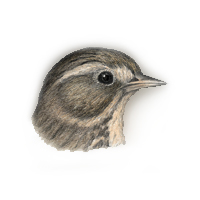|
Field
Guide IDs: BREEDING:
Alpine and arctic
tundra. 1 brood. DISPLAYS:
Male performs
repeated courtship flight ascending 50'-200',
floats downward singing, with legs extended and
tail held upward at sharp angle. NEST:
Sunk in ground and
partially overhung by rock or veg; of grass or
grass and twigs, lined with fine grass, occ hair.
Rarely a shallow scrape or built on old nest. Built
in 4-5 days. EGGS:
Dull or gray white,
marked with grays, browns, occ so blotched as to be
solid brown. 0.8" (20 mm). DIET:
Includes mollusks,
crustaceans; also some berries. Occ forages in
shallow water. CONSERVATION:
Winters s to
Guatemala and El Salvador. NOTES:
Habitually bobs or
swings tail when walking. Occ migrates to lower
elevation during breeding to escape adverse
weather. Male feeds female during incubation, but
away from nest. Young birds gather in late summer
flocks. Forms large winter flocks, often in
cultivated fields and along beaches. Widespread
across Eurasia. Formerly called Water
Pipit. Uncommon to fairly
rare migrant and winter resident in areas having
broad expanses of short vegetation. Occurs
primarily in the dry bed of Lagunita in fall and in
short grassland near the Dish, although may
occasionally visit playfields and the
Oval. ESSAYS: Walking
vs. Hopping;
DNA
and Passerine Classification;
Breeding
Season. REFERENCES:
Catzeflis, 1978;
Miller and Green, 1987; Verbeek, 1970. |
